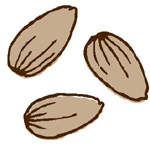Sugar Cube (5 page)
Authors: Kir Jensen

Eggs:
I almost always use large eggs because they have just the right volume and the perfect ratio of yolk to white. If I specify extra-large, it’s because the recipe relies on a slightly higher volume, so don’t substitute. Although there’s technically no difference in flavor between brown and white eggs (it’s just the breed of hen that makes the egg shells a different color), there is a huge difference between store-bought and farm-fresh eggs. Farm-fresh eggs have darker orange yolks and more flavor—perfect for custards and ice cream bases—because the hens eat a more varied diet. They’re also
much fresher, usually just a couple days past being laid. You can tell because the yolks and whites look perky rather than runny. Heck, build your own coop if you have the space, and raise some chickens yourself! When I do have to buy eggs at the store rather than the farmers’ market, I prefer hormone-free, locally raised eggs (like Stiebrs Farms). Local means they’ll be fresher, so they’ll perform better and taste better.

Flour:
It’s one of the most basic elements of pastry, so make sure it’s the best. I use unbleached all-purpose flour for almost everything and typically reach for Oregon-produced Bob’s Red Mill or Shepherd’s Grain (which is also sustainably grown by a cooperative of small family farms in Oregon). King Arthur is also a good brand. Other flours I use for added flavor and texture, such as wheat, graham, nut, and buckwheat, tend to go rancid quickly, so store them in the freezer.

Fruit:
You’ve heard it hundreds of times from hundreds of sources, but I’ll say it, too: Buy your fruit in season, preferably from a local source. It
will
taste better, no doubt about it. Still, you shouldn’t just blindly buy something just because it fits those two criteria. Think about it: If you had to choose between making a dessert with ripe, juicy, bursting-with-flavor strawberries and making one with dry, tasteless (but pretty!) strawberries, which would you pick? Stupid question, right? Not necessarily, because all too often people pick fruit based on how it looks (or the price per pound) without taking time to really hold it, examine it, smell it, ask for a taste. Those who don’t really know what they’re getting will very often end up with something sadly inferior. So be choosy. Be critical. Be forthright enough to ask for a taste—any good produce monger will be more than happy to geek out with you about produce and let you sample his or her goods.

Honey:
There’s no sense getting cheap, plain honey. It’ll just taste sweet and one-dimensional, so you might as well use granulated sugar. If you’re going to bake with honey, get something flavorful and unprocessed, so the nuances haven’t been cooked out. I love going to farmers’ markets to get local honey in a variety of flavors. I absolutely love meadowfoam because it has such a strong vanilla taste with complex pine undertones. Other good, flavorful honeys include lavender, wildflower, chestnut, and, if you like it really strong, buckwheat.

Nuts:
Almonds, pecans, and hazelnuts are my favorite nuts to bake with. I keep them in the freezer so they stay as fresh as possible. There’s a big difference in flavor between the mass-produced bags of nuts at the supermarket and farm-fresh nuts purchased from the source. If you can’t get nuts at the farmers’ market, look around online. Lots of farms sell their nuts directly to consumers through their Web sites.

Olive oil:
There’s neutral, inexpensive extra-virgin olive oil for sautéing, and then there’s super-flavorful, cold-pressed, extra-virgin olive oil for drizzling. You need both. Not just one or the other.
Both
. Drizzle-worthy olive oil is pricey, but a little goes a long way. Some oils are burn-your-throat spicy and grassy, but I prefer something a touch milder and fruitier to use with chocolate and other sweets. Always sniff and taste your oil before using. If it smells musty, soapy, or acrid, it’s gone rancid and will taste awful.
Salt:
I use sea salt for everything because it comes in so many flavors, colors, and textures. When I’m adding salt to a batter, I usually use something fine grained, so it fits into measuring spoons better. For finishing salts, the sky’s the limit, but I generally aim for something delicately flaky, like fleur de sel or Maldon. They add texture without being too coarse. For more on salt see
The Don
.

Spices:
Ground spices lose their mojo pretty darn quick. They might look fine, but the flavors start to fade at six months and just get fainter and dustier as time goes on. One of the best options, though it requires a bit more patience, is to grind whole spices yourself in a spice grinder. Nutmeg, for sure, is one spice that I always use freshly ground, and you don’t need a spice grinder to do it. Just grate the whole nutmeg on a Microplane until you have what you need
for the recipe. If you are going to buy preground spices, buy smaller amounts so you can use them up before they lose their flavor. Places like Penzeys and The Spice House source the highest-quality spices, and you can order from them online. You can also check out the bulk section at your supermarket and buy smaller amounts that you’ll use up fast. (Make sure it’s a store with high turnover, so the bulk spices aren’t old to begin with.)
Sugar:
I prefer cane sugar over beet sugar, so C&H is my go-to brand. I use C&H’s superfine “baker’s” sugar instead of regular granulated sugar because it dissolves faster and therefore incorporates more quickly than regular granulated sugar. It also looks extra pretty when sprinkled on cookies, cakes, and pies. When I need brown sugar, I often reach for C&H “dark” brown, which is really as light as I like to go. If I need truly dark brown sugar, I get muscovado (a lot of supermarkets carry small bags of this on the baking aisle), which is almost chocolate brown because of its high molasses content.

Vanilla:
There’s a common theme in most of my recipes: Vanilla appears in almost all of them. Vanilla rounds out the rough edges of other flavors and adds depth. Although it can certainly stand on its own, it’s an important supporting player, too. I always use high-quality pure vanilla extract from Penzeys or The Spice House because the flavor is more intense, nuanced, and I can select the variety of bean used, from Mexican to Tahitian. Whatever you do, don’t get a cheap version that’s mostly alcohol and water spiked with additives, or an imitation extract.
Sometimes extract isn’t enough and you need the intensity of flavor that only comes from actual vanilla beans. So stock up on plump, fresh, high-quality vanilla beans (Tahitian is my favorite because it’s so floral). For the best prices, shop online and buy your beans in bulk. You can also buy vanilla bean paste, which is essentially a jar of vanilla bean seeds in a vanilla-flavored gel so you can skip the hassle of dealing with the pod. For more on vanilla, read the
Vanilla sidebar
.

